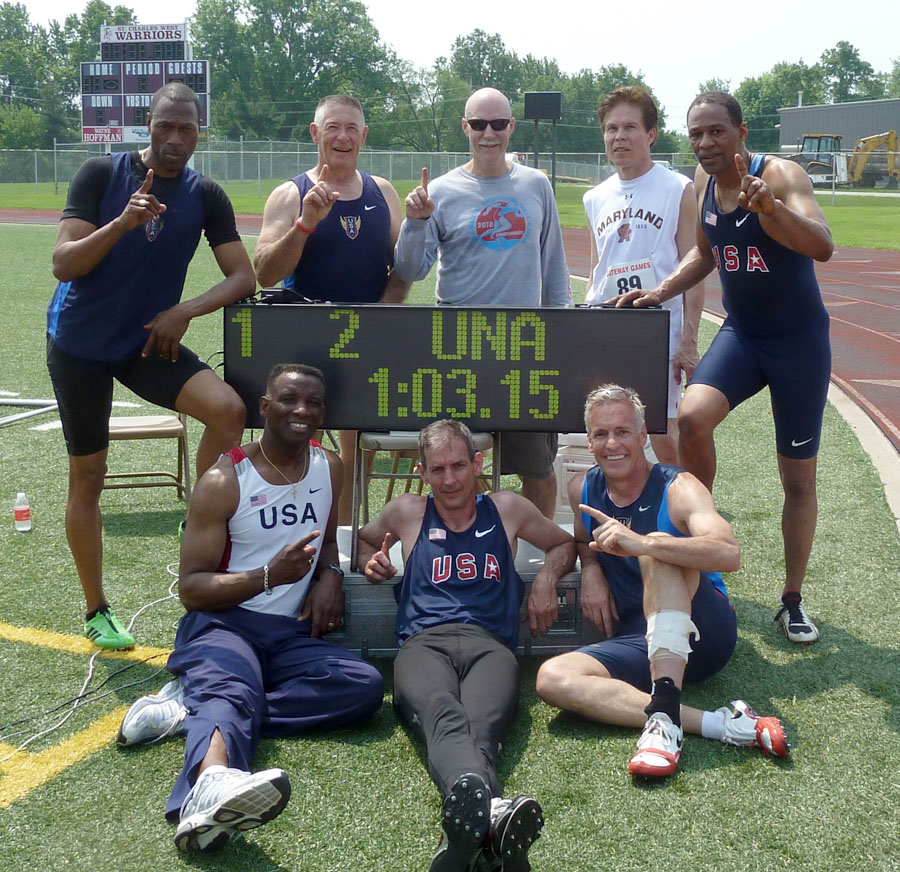American Record falls twice in the M50-59 shuttle hurdle relays
A friend graciously filed a report on a masters shuttle-hurdle relay record broken outside USATF masters nationals. He writes: “The M50-59 American Record was broken (twice) in the Shuttle Hurdle Relay on May 19 at the 7th Annual Gateway Games. (See results here.) There were two shuttle hurdle relay races—each race with two teams. The winning M50-59 mark was set in the first heat in a time of 1:03.15. The relay team consisted of Robert Stanley, Mark Williamson, Eugene Anton and Darnell Gatling setting the new record. The second heat consisting of Robert Stanley, Mark Williamson, Keith McQuitter and Darnell Gatling had a time of 1.03.25 which also broke the prior American Record of 1:04.29. Hurdlers journeyed from Massachusetts, California, Illinois, Wisconsin, North Carolina and Oklahoma to participate in the event.”
My reporter continues:
In the future we plan on organizing the Shuttle Hurdle Relay in different locations throughout the country so that more hurdlers are able to participate and more spectators are able to experience this exciting event. We also plan on making this an annual event at the Gateway Games.
“We were also very meticulous in making sure all record requirements where followed and the paperwork has been submitted for the American Record,” said Jeff Davison.
Anton and Davison organized the SHR event and will be organizing teams to compete at Nationals in Kansas this summer.
In addition to the Shuttle Hurdle Relay American Record, Quintin Stephens set a personal best and qualified for the Adult Para Nationals with a club throw of 15.93 meters. Disabled veterans traveled from as far away as San Antonio Texas to compete in the Masters division.
The Disabled Athlete Sports Association (DASA) www.dasa.org puts on a wonderful USATF sanctioned weekend event open to all abilities including youth and masters and was gracious enough to include the Shuttle Hurdle event to their weekend of competition.
DASA provides competition for those individuals with a permanent physical or visual disability or those that are deaf or hard of hearing and who have difficulty participating in sports with non-disabled peers.
The Gateway games included a weekend of Track & Field for both abled and disabled athletes, Swimming, and Archery events. DASA encourages everyone to “Discover the Ability Within. Each of us has a different ability. Discover yours today!”






6 Responses
Congrats gentlemen, your event humbles me always! Makes me think that a meet set up just for relay records is the next step. Someone please get it done.
This event is one of the most complicated in T&F and requires an amazing amount of concentration on the already highly skilled athletes. Although having watched the event since the early ’60’s at all levels, I never read or heard the technical requirements for determining just when members two through four of the relay were to start: does the previous runner have to touch the next runner? Does the chest of the previous runner have to cross the finish line before next runner starts? If the latter, there are no FAT sensors and photos at both ends. Since this is not an official event in the Olympics or in IAFF, no rules there. I have seen numerous violations, even among highly skilled collegians (i.e, Penn Relays), although I seriously doubt anyone was trying to consciously gain advantage. It simply looks very difficult to judge when to start legs 2 through 4. Any responses?
I’m sure eagle-eyed judges watch to make sure runner’s torso has passed line before next runner starts. Lots of relays involve judgment calls — such as when the baton is exchanged. A judge can tell if someone is outside the zone, for example. No sensors needed for relay exchanges.
Our shuttle hurdle team in Lisle handled it this way: Runners 1 and 3 were at one start line of the hurdle set up, runners 2 and 4 at the opposite start line. The start line for 1 and 3 was the finish line for 2 and 4, and vice versa. Hurdler #4 watched for the incoming hurdler #1 and waited until her torso crossed the line before shouting GO to the outgoing hurdler #2 who was waiting in the blocks. Hurdler #3 used a standing start not a block start, so she was able to watch for incoming hurdler #2 and wait until that hurdler had crossed the line before her start. Hurdler #4 was in the blocks, and #1 watched for incoming #3 before shouting GO to outgoing #4. And yes, judges kept an eye on everything!
Its not like the Penn Relays. The runner must cross the finish line just as in a regular finish of a race before the next runner can move. There are officials at both ends and along the track as well as FAT time. Regulated enough for ya?
\The meet was an open and special event meet. Not a meet for relays. This race can be added to any meet as long as the officials and organizers can get it together as they did for this meet.
2014:
How about 2014 in Austin, Texas area?
Leave a Reply